Blind Casting for Albies
Catch more false albacore by focusing on structure and bait instead of chasing the blitz.
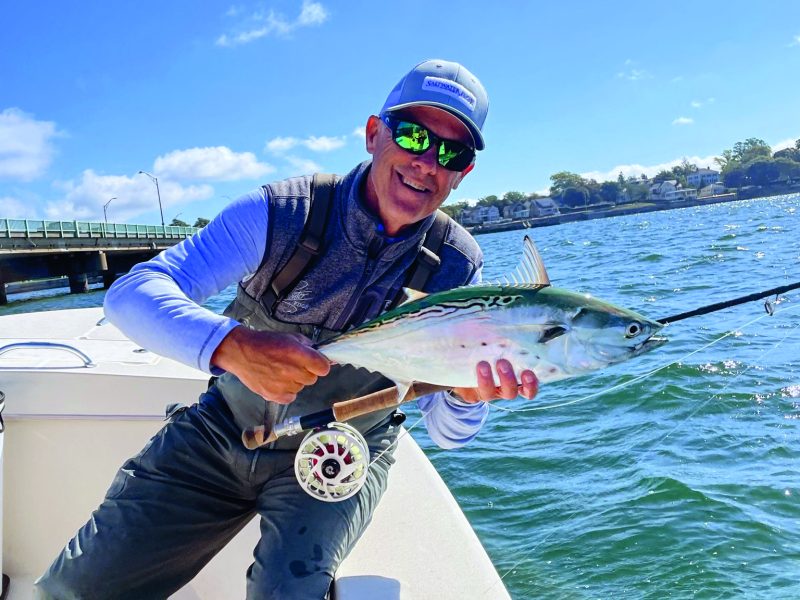
There is a saying in golf, “Drive for show and putt for dough.” While catching false albacore from a frothing surface feed is one of the most exciting experiences a light tackle angler can have in the Northeast, a primary focus on “blind casting” will improve your score dramatically. The advantages of blind casting apply to both light-tackle and fly-rod fishing. Renowned fly-tyer Dave Skok, who has won the albie shore fly division of Martha’s Vineyard Derby more than anyone, estimates that he caught 70 percent of his albies while blind casting. There are quite a few reasons the prize goes to the blind caster.
Ultimate Stealth
By focusing on blind casting, you maintain one of an angler’s most critical advantages: stealth. In popular spots, both boat and shore anglers must deal with crowded conditions. For the boater, it is simple to set up a drift over likely structure away from the madness, or to anchor up and pound the zone with offerings while keeping an eye on the fishfinder.
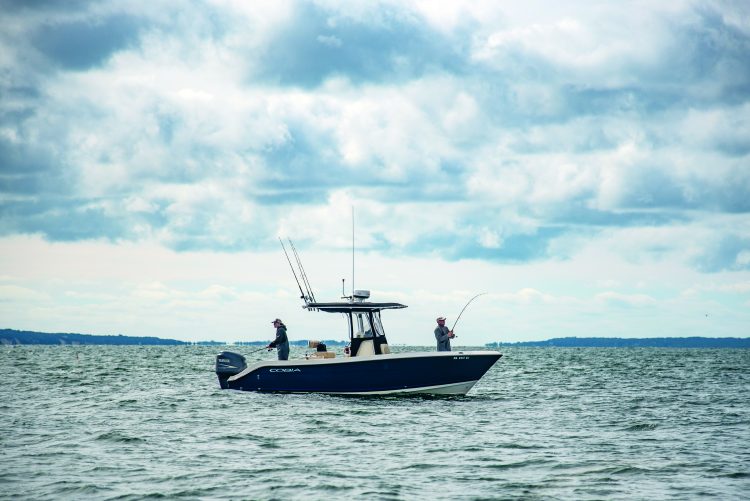
Built For It
Observations of albie feeding behavior describe a wolfpack or squadron in constant motion working in a synchronous effort to maximize their calories while minimizing individual effort. They chase down and corral their target, forcing the school to tighten up while pushing it to the surface or into structure. Individuals then use their speed and eyesight to attack with maximum efficiency. These wolfpacks can vary from a half dozen to hundreds of albies.
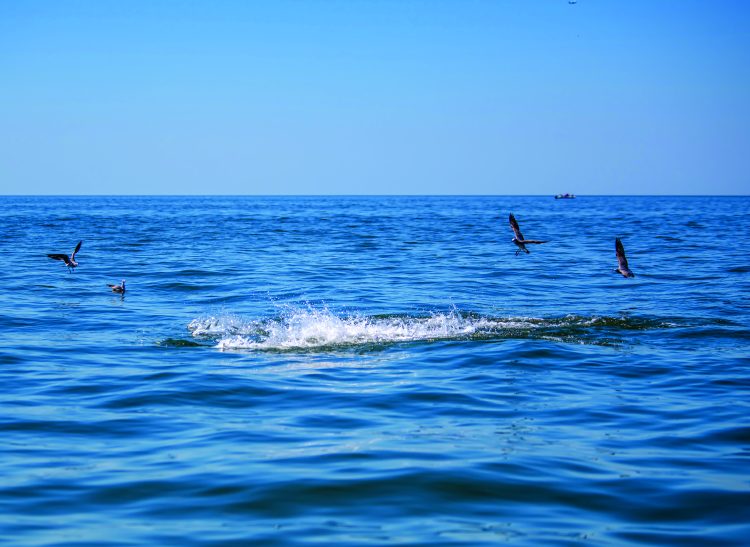
“Must Haves” For Blind Casting
Bait
In order to feed most effectively, albies need concentrations of bait. Ideally, tight-schooling baits like peanut bunker and bay anchovies create the most sustained feeds. However, plenty of frothy feeds have occurred with sand eels, silversides, and butterfish. And, there’s the steady but maddening sippy feeds on snot bait and nearly transparent crab larvae. Beggars can’t be choosers, but you need bait … and some are better than others.
Moving Water
The other false albacore “must have” is moving water. Typical albie hangouts include inlets, points, and rips that constrict current and concentrate bait, creating the “physical advantage” mentioned earlier. Feeding tends to scale with the tide and can be furious as current speed peaks. Look for a repetition in the feeding patterns of false albacore and always take a look at the bottom structure as it can provide critical information. The best opportunities are related to the physical advantage created when a pod of bait encounters the structure and reacts to it. The repetition is the albies sticking with a plan that works and moving from pod to pod.
Reading the Water
Another advantage all anglers have, and the better ones leverage to great effect, is observation. It is critical that you eliminate ocean and determine specifically where you can stack the variables and most likely find success. Like a lot of gamefish, albies use edges to their advantage. In the case of false albacore, some of the most intense feeds occur around steep edges, either hard or soft.
Hard and Steep
Most steep, hard structures are well known and include the West Wall in Point Judith, Rhode Island, and the South Cape jetties or Sandy Point in Jersey. There are loads of smaller (and less crowded) options. Keeping these general rules in mind will help you find your own.
It’s tough to beat the bait buffet created by young-of-the-year baits being swept out of an inlet or breachway on a dropping tide. Despite this steady stream of food, in my experience, the bait is less concentrated and the opportunities less consistent. On the incoming tide, albies routinely run into the harbor or salt pond to hammer the aggregating bait as well as feed along the length of the structure.
Take the time to study the water tight to the rocks and search for areas along that length where bait may stack up. This might be an outcropping or rock that was dislodged by a winter storm and resulted in an eddy. These dents and divots along the wall can be the “spot within the spot.” This is particularly true on the incoming tide, when bait is swimming against the tide and takes whatever refuge it can find along the structure’s length.
In my home waters around Newport, Rhode Island, there are many reefs, cliffs and steep, hard drop-offs courtesy of the Wisconsin Glacier 75,000 years ago. This type of structure has a number of benefits for the blind caster. Steep, hard structure helps a shore angler reach more fish since they tend to travel closer to a drop-off with the security of 20 or 30 feet of water nearby.
The tips of the points themselves (natural or manmade) create opportunities because the hard structure deflects the longshore current seaward, and the bait buffet typically “hook” down-tide and try to regroup in the eddy. While this eddy will move to some degree, it creates a blind-casting opportunity in the same general vicinity, bait ball after bait ball, creating consistent action close to shore for a good portion of the tide.
Soft and Steep
Anglers should also be on the lookout for strong currents close to sandy shores that carve steep drop-offs along the beach. For example, this may occur on a corner in an outflow or adjacent to a jetty. When bait gets trapped in these situations, they tend to hug the shore to get out of the current, and mayhem ensues. In these glorious scenarios, with the bait unable to go anywhere, the fishing stays very good until the tide wanes.
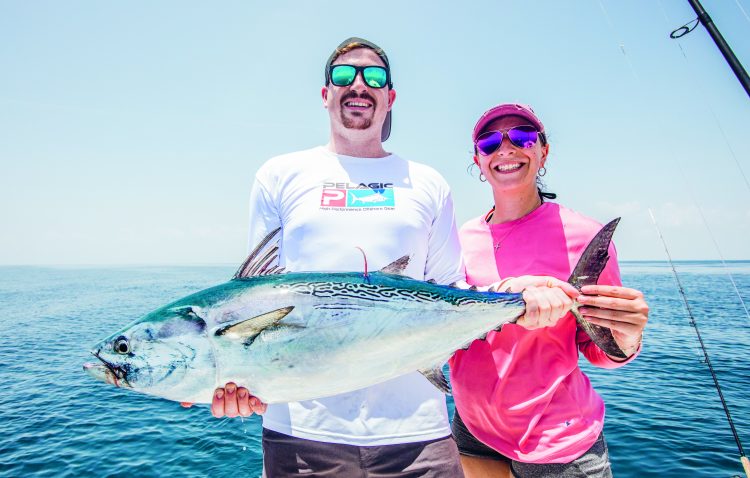
Don’t Skip The “Frog Water”
Another blind-casting hot spot exists in the type of water a trout fisherman would call “frog water.” It is the water you wade through to get the prime water. In “frog water,” there is not much current or structure to speak of, but these areas adjacent to the more obvious action is where blind casting can really pay off. Let me paint a picture.
It’s an hour into the incoming, and the tide is starting to crank. Bay anchovies are abundant, and numerous rusty patches are visible in the water. Pretty soon, albies start popping consistently at the far end of the reef and then progress along it. After a look at the fishfinder, the observant angler would recognize that the albie wolfpack has a tremendous physical advantage using the reef and speed to overtake the struggling bait ball; that is, until they run out of reef.
While the advantage of the structure diminishes, two of the critical components remain: bait, albeit unfocused, and plenty of charged-up albies. In my experience, this is a blind-casting hot spot often devoid of other anglers. In this scenario, I “match the hatch” and “look alive” as the wolfpack is in search mode, and the most natural presentation seems to work best. After cleaning up a few of the stragglers, they move on, get the band back together, and find a more concentrated opportunity, which is often back at the other end of the same structure. On the best days, it’s rinse and repeat.
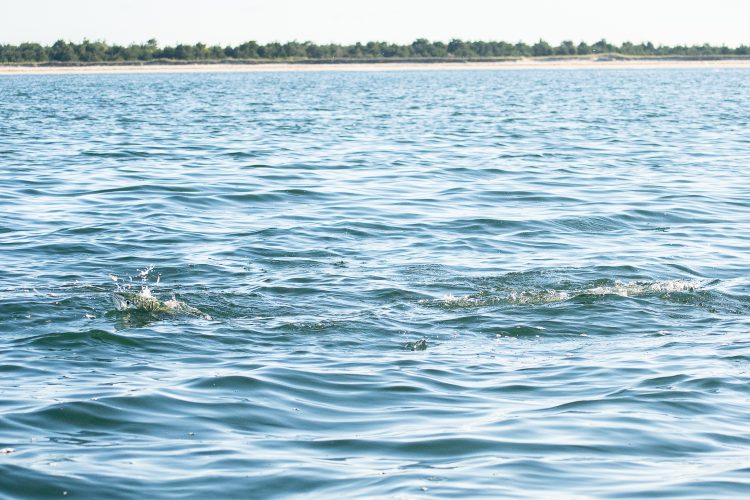
At slack, I focus my efforts in the area that, when the tide is running, has most of the bait, but as the tide really cranks and the running and gunning intensifies, I slide into the “frog water.”
Beware Of Speed Bumps
A couple of seasons ago, a friend was in town and there appeared to be ideal, nearly flat conditions, I ran the milk route of albie hot spots from Narragansett to Point Judith to the Breachways of South County with barely a bird, let alone a swirl to show for it. We were ready to turn around when we saw the littlest patch of nervous water a bit further offshore. We slowly motored over and found albies feeding a bit deeper. They only occasionally created a surface disturbance over a “speed bump” of structure that made the bait stall or change direction. A look at the fishfinder showed pods of concentrated bait in the mid- to lower water column.
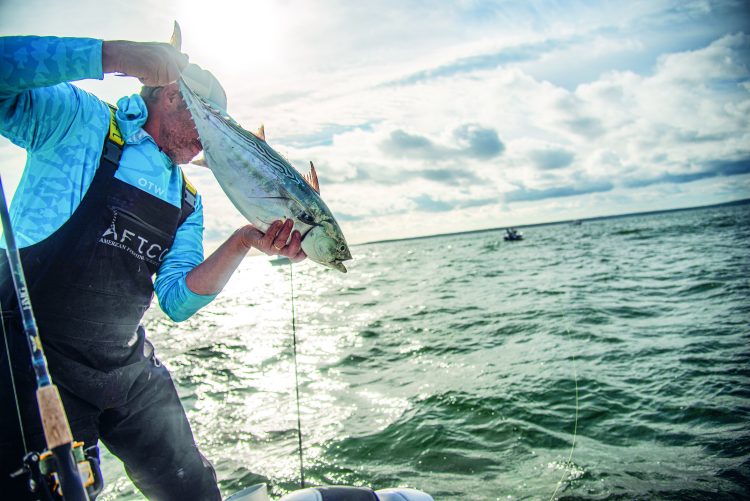
My co-worker, Eric Spicer, points out that taking the time to explore the entire water column can pay off. He adapts the same vertical jigging techniques used for bluefin to fool albies feeding close to the bottom.
As I mentioned earlier, all baits are not created equal in that silversides and sand eels are abundant but are not tight schooling. I think these particular baits are the ones that earn albies the reputation of being picky. In this scenario, a bit of structure and some silversides along an otherwise smooth beach should bring the components together for screaming reels on repeated drifts until the tide slacks out.
Blind Casting Tactics
Regardless of your preferred method, when blind casting, it is critical to keep your lure or fly in the water. It’s smart to probe different parts of the water column, but a few feet below the surface seems to be the sweet spot.
For light-tackle anglers, make long casts along and perpendicular to the structure you are targeting, coupled with a slow retrieve and only occasional twitches to get a flash from the lure. Be mindful of using lures, particularly jigs, that are too heavily weighted and fall through the water column too quickly. Remember, the goal is a steady slow to moderate retrieve a few feet below the surface until your fishfinder suggests otherwise. Soft plastics with built-in action like the Hogy Slow Tail, small suspending stickbaits like the SP Minnow, and lighter metal jigs create the slow flutter you are trying to achieve.
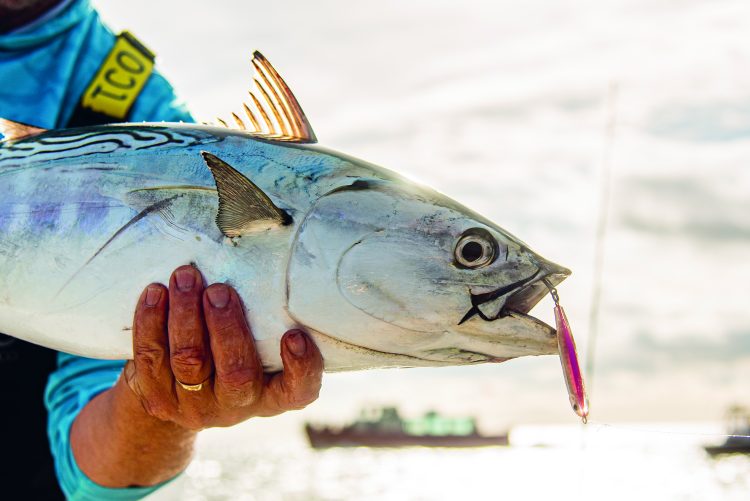
For fly anglers, a slow, hand-over-hand retrieve is most effective for a couple of reasons. First, you are connected to the fly at all times. This creates a steady pace that is easy to vary. My “go-to” albie fly for blind casting is Captain Jamie Boyle’s Bonito Bunny, both the weighted and unweighted versions. These flies, on a slow retrieve, cover a lot of bases and there’s a lot of “look alive” action in the bunny fur. It suggests many smaller baits, including small squid, And, with a cone head added during the slowest retrieve possible, it resembles a stunned baitfish falling to the bottom.
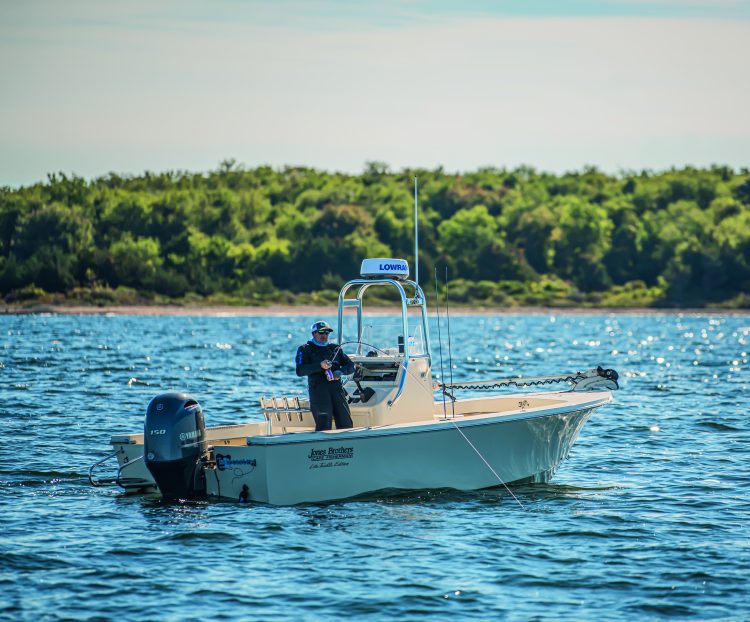
There is no need for fast retrieves or bright colors when blind casting. Take a moment to observe the prey species as I doubt they are either fast or fluorescent.
One of the sure things about blind casting is most of the fish you catch hook themselves. I get the sense that they are so confident in your offering that they just freight-train it and keep going. Albies feed by overtaking their bait, so a slow, steady presentation is an easy mark. In anticipation, don’t set your drag too tight and be mindful of managing your fly line on the deck.
Let The Birds Be Your Eyes
Whether you are shore-bound or have the added flexibility of fishing from a boat, be sure to process the clues that bird activity can provide. Albie schools attract both gulls and terns.
When you see high-circling and hovering birds, they are in a tracking pattern and often following a school that is swimming beneath the surface. Obviously, wheeling and diving birds are anticipating taking advantage of bait that has been pushed to the surface.
The next time you grow frustrated by albies or, more likely, by the crowds they attract, commit to blind casting. I think you will be very pleased with the payoff. To bring it back to golf, the hilarious Lee Trevino once said “Putting gets really difficult the day they hand out the money.”
Related Content
How to Catch More False Albacore
2 on “Blind Casting for Albies”
-
Ron C. Sandy Point????
In Nj?Sandy Hook, maybe….
-
Paul Vieira Hi Peter, Excellent article!!
Leave a Reply